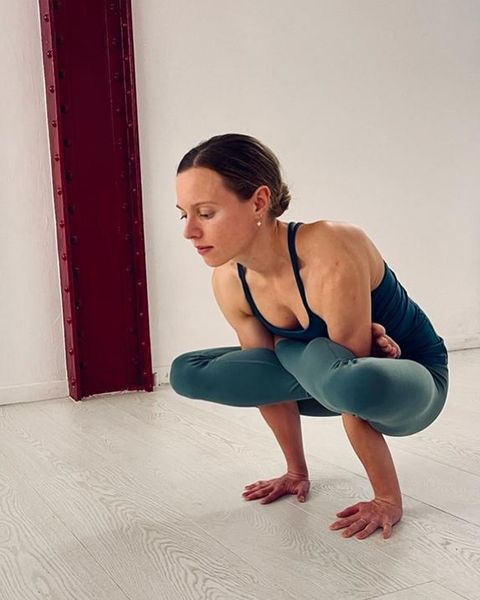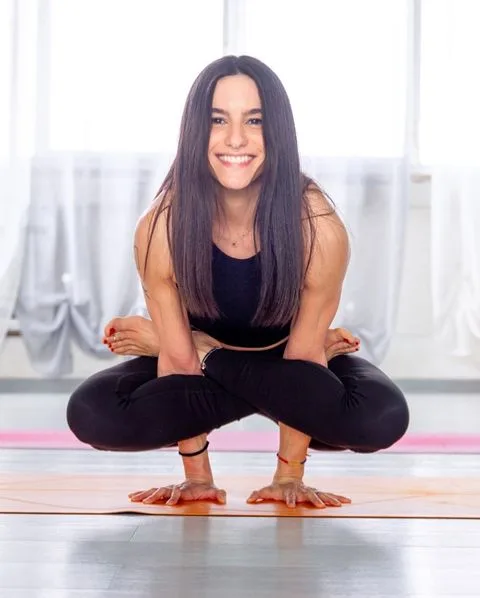Kukkutasana, also known as Cockerel Pose, is a balance posing on the arms, assuming Lotus Pose, put the hands between the thighs and calves, plant them firmly on the floor, lifting the body in the air.
The Kukkutasana (Cockerel Pose) is one of the top positions located in the middle of the first series of Ashtanga Vinyasa Yoga.
Information
| Known as: | Kukkutasana, Cockerel Pose, Rooster Pose, Cock Pose |
| Sanskrit name: | कुक्कुटासन |
| IAST: | kukkuṭāsana |
| Pronunciation: | kuh-kut-ah-SAHN-nuh |
| Level: | Advanced |
| Total time: | 1 to 5 minutes |
| Type: | Arm balancing, sitting, forward bend |
| Drishti: | Forward; Third eye |
| Chakra: | Muladhara Chakra |
| Focus: | Arms, wrists, elbows, shoulders, chest, abdominal, gluteus, hips |
| Indications: | Perineum, arms, internal organs, abdominal, digestion, central nervous system, adrenal gland, smooth blood flow, induces good sleep, metabolism, immune system |
| Preparatory poses: | Easy Pose (Sukhasana), Lotus pose (Padmasana), Root Lock (Mula Bandha), Scale Pose (Tulasana) |
| Follow-up poses: | Hidden Lotus Pose (Gupta Padmasana), Upward Lotus Pose (Urdhva Padmasana in Sarvangasana), Headstand II (Sirsasana II), Corpse Pose (Savasana), Cobra Pose (Bhujangasana), Crocodile Pose (Makarasana) |
| Contraindications: | Knee, or wrists injuries, weak or pain in elbow, osteoporosis, sciatica pain or pain in the lower back, migraine, pregnant women, menstruation, high blood pressure, heart or lung problems, hernia, prolapse, gastric ulcers, enlarged spleen |
Meaning + Origin
Kukkutasana derived from the Sanskrit name that made from two words — Kukkuta + Asana:
- “Kukkuta” = “cock, or cockerel, or rooster”
- “Asana” = “pose or posture”
Kukkutasana is known as Cockerel Pose, because the shape of the body resembles that of a cockerel. This yoga posture is said to be useful in the process of awakening Kundalini. The pose strengthens your arm and shoulder muscles and gives a feeling of leverage. Normally the weight of your body is on the legs and feet, but in this yoga posture it is changed and hence the energy of the body flows in a different direction.
In another sense of the meaning, the rooster, the male chicken, represents virility. Practicing Kukkutasana (Cockerel Pose) concentrates sexual energy, which can be redirected to enhance the virility of the body.
The sixteenth-century Persian text Bahr al-hayat1 (c. 1602) called this pose the Sthambhasan (Thambha Asana).
The text further states that “when performed, the amount of earth and water in the body will decrease and that of air and fire will increase.”
The book is the first illustrated textbook on yoga. Bahr al-hayat means the ocean of life. The book was translated from the Sanskrit original and published in 1602 by Muhammad Ghawth Gwaliyari 2.
The Kukkutasana is an ancient yoga Asana that is described in the Thirumanthiram, the Ahirbudhanya Samhita (7th century Ahirbudhnya Saṃhitā), and the Vasishtha Samhita (13th-century yoga text). As for the age of these texts, they are much older than medieval Hatha Yoga texts such as the Hatha Yoga Pradipika (15th-century 1.23) and the Gheranda Samhita (17th-century 2.31).
The stages of performing Kukkutasana are described in Verse 561 of Thirumanthiram. Thirumanthiram is a Tamil poetic work by Thirumoolar probably written between 200 BC to 700 CE.
Therefore, it is clear that this Asana is an ancient yoga Asana that has been in practice for more than one thousand five hundred years. In addition, it is one of the non-meditative postures that were in practice before Hatha Yoga even existed.
Benefits of Kukkutasana (Cockerel Pose)
The Kukkutasana (Cockerel Pose or Rooster Pose) is arm balancing, stability, core strength, and flexibility posture, however, the physical and mental benefits of this pose are listed below:
- Physical Benefits:
- Strengthens the arms, wrists, ankle, knee joints, core muscles, gluteus, and pelvic floor muscles
- Promotes smooth blood flow
- Stretches the hips, thigh, back muscles, and chest muscle
- Improves the mobility and flexibility 3
- Improves stability, balance, and self-confidence
- Enhances the production of digestive enzymes and juices
- Improves the digestion
- Massages the digestive organ, stimulate adrenal glands which regulates metabolism, blood pressure, and immune system
- Tone the abdominal muscle
- Reduce extra belly fat
- Activate the Muladhara Chakra and awakens the Kundalini
- Mental Benefits:
- Induces good sleep
- Reduces stress
- Reduces anxiety and restlessness
- Improves concentrations
- Sharpen focus
How to do Kukkutasana (Cockerel Pose)

Instructions:
- Sit in Padmasana (Lotus position).
- Insert your right arm between your right thigh and calf muscle, and your left arm between your left thigh and calf muscle.
- Place your palms of the hands firmly on the floor with your fingers pointing forward.
- Balance the weight of your body on the hands and raise your body off the floor.
- Your arms and wrists will have to be strong to support your body.
- Inhale slowly as you raise your body.
- Hold your breath in the final position, or breathe normally. Remain in the final pose for at least 1 minutes to 5 minutes or as long as is comfortable, keeping your head straight and your eyes fixed on a point in front.
- Note: The duration of holding the pose can be extended as long as it is comfortable for you. Initially, it is not possible to hold the position for more than a couple of minutes.
- However, as the practice progresses, you can increase it to 5 minutes or as long as is comfortable.
- To come from the pose, reverse the process and exhale while lowering your body to the floor.
Tips: If you have a lot of hair on your legs, it may find it difficult and painful to insert your arms between your thighs and calves. Shaving your legs or applying oil to them will reduce the problem. You have a lot of fat or muscle in your legs will also have difficulty.
Beginner’s tip
- To find balance in this yoga posture, gaze at a point or object when the body is off the floor.
- If you find it difficult to put the hands between the legs, apply oil on the forearms and inner thighs.
- When you are raising the hips above the floor, then apply the mula bandha, that is, pull the anus upwards.
- Do not lean forward on the back, if you do, you will immediately lose balance and fall forward.
Prop tips
- If you’re afraid of losing balance when you get off the floor, place a bolt in front of you to hold you in such a position. Otherwise, you may run the risk of getting hurt in this pose.
- If you do not have a good grip on the legs in a cross-legged posture like Lotus Pose (Padmasana), then place thin folded blankets on the thighs.
Common mistakes
Practice Kukkutasana (Cockerel Pose) with mindfulness and awareness of your body. Remember to take deep breaths throughout the pose and to only stretch as far as is comfortable for you by keeping attention to your body. With practice and patience, you can gradually improve your form and reap the benefits of this challenging yoga pose.
The following five possible common mistakes you can make when performing Kukkutasana (Cockerel Pose), which can affect the effectiveness of your pose and maybe cause the injury:
- Excessive forward bending: Maintain a balance between the weight on your hands and the weight on your feet, while practicing this yoga pose. Overly forward leaning increases your risk of falling forward and losing your balance. To avoid this, make sure you engage your core muscles to help maintain your balance and distribute your weight evenly.
- Gripping the ground too forcefully: Gripping the ground too strongly can lead to stress in your shoulders and arms, making it challenging to lift your feet from the ground. Instead, focus on applying pressure to the floor with your palms and fingers, keeping your hands relaxed.
- Too-high hip raise: Your lower back and shoulders may be put under stress if your hips are raised too high. As an alternative, try to keep your body in a straight line from your head to your feet by lifting your hips up until they are above the ground.
- Crossing the ankles the wrong way: Crossing your ankles the wrong way can make it difficult to balance in the pose. Be sure to cross your right ankle over your left ankle, and keep your ankles together.
- Straining the neck: Looking up too much can strain your neck and cause discomfort. Instead, keep your gaze straight ahead or slightly downward.
Precautions and contraindications
You must take care while practicing Kukkutasana (Cockerel Pose) as this yoga pose is considered to be an advanced arm balance pose.
However, the following are the precautions and contraindications of this yoga pose:
Injuries
Injuries to the hips, knees, wrists, shoulders and back are a contraindication, so it is best to avoid the practice of Kukkutasana (Cockerel Pose).
Migraine, heart, or lungs issues
If you are suffering from migraine, or have issues related to heart or lungs, then the practice of Kukkutasana (Cockerel Pose) should be avoided.
Pregnant women and menstruation
Pregnant women should avoid it, and even those who are menstruating should avoid it.
Other problems
Individuals with problems such as carpal tunnel syndrome, arthritis, high blood pressure, spondylitis, back pain, hernia, prolapse, gastric ulcer, enlarged spleen or knee injury should avoid this practice.
- Bahr-ul-Hayat is a Persian rendering of the Amrtakunda, a Sanskrit text on yoga: https://en.banglapedia.org/Bahr-ul-Hayat[↩]
- https://en.wikipedia.org/wiki/Muhammad_Ghawth[↩]
- Assertion of traditional yoga in human health and value education. M. Bera. 1, February 2007. Education; of the thesis submitted to UNIVERSITY OF PUNE FOR THE DEGREE OF DOCTOR OF PHILOSOPHY (EDUCATION) DR. S.A. SONAWANE RESEARCH GUIDE DEPARTMENT OF EDUCATION & EXTENSION UNIVERSITY OF PUNE, MAHARASHTRA.[↩]















